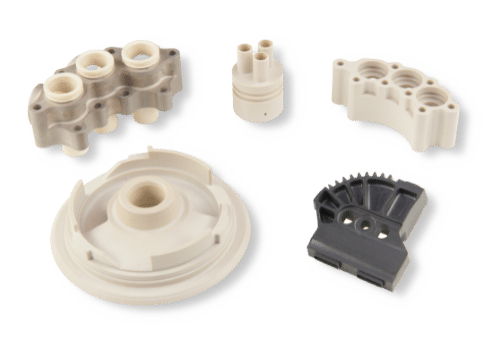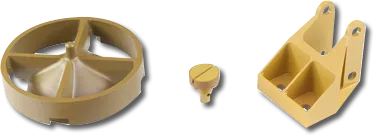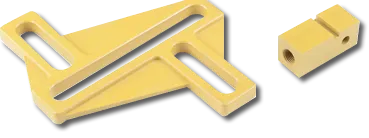Material Comparison
When selecting high-performance plastics for demanding applications, understanding their distinct qualities is essential. Each of these advanced thermoplastics offers unique characteristics—such as heat and chemical resistance, mechanical strength, and biocompatibility—that make them ideal for specialized uses in industries ranging from aerospace to medical and electronics. These comparisons will help you identify the ideal plastic for your application by examining critical properties, processing capabilities, and overall performance in high-stress environments. Whether you need cost-effective durability or extreme thermal resistance, find the plastic that meets your specific project needs.
PEEK vs. Ultem
Both high-performance thermoplastics, PEEK and Ultem, demonstrate various material features that make them a favorable choice for thermal or electrical applications. Some key material differences include:
- Heat Resistance: Semi-crystalline PEEK offers higher heat resistance, able to withstand performance at temperatures seeing 500º. Ultem is an amorphous plastic with a maximum continuous operating temperature of 340º and may rubberize over time if subjected to excessive heat.
- Chemical Resistance: Both materials feature excellent chemical resistance. Ultem resists a wide range of chemicals and meets strict fire safety standards, while PEEK has superior resistance and is only dissolvable in concentrated sulphuric or nitric acid.
- Mechanical Properties: While both materials provide excellent electrical insulation, PEEK offers friction and wear properties through high tensile strength, flexibility, and impact resistance to maintain structural integrity. On the other hand, Ultem offers tensile strength and impact resistance for durability.
- Processing Capability: Ultem can be easily machined or processed in material processing operations, but PEEK’s higher resistance capabilities may make it more challenging to process. However, PEEK is compatible with CNC milling in its solid state.
- Cost: As one of the most expensive thermoplastics available, PEEK has exceptional material characteristics for demanding applications, while Ultem is more cost-effective and demonstrates many similar properties.
Ultem and PEEK are widely popular across industries. These materials are both ideal for aerospace, automotive, and electrical applications. PEEK is also used in oil and gas, medical devices, and semiconductor manufacturing applications, where Ultem is commonly found in consumer goods.
Vespel vs. PEEK
When it comes to high-performance plastics, Vespel and PEEK offer similar thermal characteristics, electrical properties, creep resistance, and machinability. But, there are key differences between these polymer materials:
- Chemical Resistance: Both materials demonstrate chemical resistance, with Vespel being highly resistant to chemical corrosion. However, PEEK offers superior chemical resistance, where only a few chemicals can damage this material.
- Operating Temperature: These polymer plastics can operate at high temperatures, with PEEK performing continuously at temperatures as high as 500º. Vespel can withstand much higher temperatures, up to 900º, for shortened periods.
- Mechanical Characteristics: While both plastics offer mechanical strength, PEEK is high-strength for toughness, demonstrating fatigue resistance, stress-crack resistance, and stiffness. On the other hand, Vespel features low friction with superior wear characteristics through its low, constant CF, performing well in high-wear applications due to its ability to function without lubrication.
- Vacuum Compatibility: Most plastics are susceptible to outgassing, but Vespel won’t outgas even at high temperatures, operating efficiently in a vacuum without contaminating the environment.
- Biocompatibility: PEEK features exceptional biocompatibility, simulating the strength and modulus of human bone. Popular in medical devices, PEEK is often used for implants and reconstructions.
Depending on the specific requirements of your application, either Vespel or PEEK may be suitable for your needs. It’s essential to closely weigh the benefits of each material to determine which high-performance plastic offers the characteristics you need for your unique project.
PEEK vs. Torlon
Torlon and PEEK are two high-performance polymer materials with distinct characteristics. They are both machinable but demonstrate unique features, including:
- Chemical Resistance: Both materials have chemical resistance properties. Torlon is resistant to hydrocarbon-based solvents, acids, and mild bases, as well as chlorinated and fluorinated hydrocarbons. Offering superior resistance to chemicals, PEEK can only be broken down by a few specific compounds.
- Temperature Resistance: While both PEEK and Torlon can operate in high-temperature applications, Torlon can handle higher temperatures without compromising its structural integrity. Alternatively, PEEK offers outstanding thermal stability in applications with operating temperatures under 500º.
- Mechanical Properties: These materials provide particular mechanical traits. Torlon is high-strength with stiffness and toughness, maintaining its strength even in extreme conditions. On the other hand, PEEK features high ductility, material resilience, and exceptional wear resistance against continuous abrasion or friction.
- Electrical Conductivity: PEEK and Torlon both demonstrate electrical properties, but PEEK features excellent electrical insulation characteristics, low conductivity, and dielectric qualities
- Cost: When budget is a concern, Torlon is a more cost-effective choice than PEEK, one of the most expensive thermoplastics on the market, due to its complex manufacturing process and ability to perform in applications where other materials may fail.
Both materials possess favorable characteristics for demanding applications. PEEK is primarily used in aerospace, automotive, electrical, and medical industries, where Torlon is preferred for high-performance hardware, transmission and powertrain components, as well as oil and gas applications.
Acetal vs. Delrin®
Acetal and Delrin® are both polyoxymethylene polymers, but Delrin® is the brand name formulation manufactured by DuPont. While acetal refers to a semi-crystalline engineering thermoplastic that is one of two distinct forms, either homopolymer or copolymer, Delrin is a semicrystalline homopolymer that is the strongest and stiffest unreinforced material option. They offer different material characteristics based on their formulations:
- Chemical Resistance: Acetal offers good chemical resistance to solvents, oils, or greases but may degrade when exposed to strong acids or bases. However, Delrin® demonstrates excellent resistance to solvents, oils, and fuels, as well as delivering more resistance against hydrolysis than general acetal.
- Temperature Resistance: Operating within a temperature range of -40° C to 100° C, acetal has good temperature resistance, but Delrin® can withstand temperatures up to 120° C.
- Processing Difficulty: Both acetal and Delrin® are easier to process than other engineering plastics, but Delrin® may require precision control in molding operations due to its higher crystallinity.
- Using Reinforcing Additives: Acetal and Delrin® can both include reinforcements, like glass fiber or mineral fillers. With acetal, these additives improve strength and stiffness. Delrin® uses reinforcing additives to enhance mechanical properties, but pure Delrin® is often used in high-performance applications.
- Mechanical Properties: Featuring high tensile strength, low friction, and good wear resistance, acetal is tough but less stiff than Delrin®, which has superior mechanical properties for increased wear resistance and stiffness in demanding applications.
- Cost: A more general-purpose material, acetal is typically cheaper than Delrin®, which is more costly due to its brand recognition, manufacturing process, and enhanced performance capabilities.
Depending on the application, Delrin® is a brand-specific, high-performance solution compared to general-use acetal. In less demanding operations, acetal delivers suitable strength, wear resistance, and chemical resistance for automotive, electronics, and food processing. Comparatively, Delrin® provides medical, automotive, aerospace, and industrial applications with a superior material solution with higher mechanical strength, wear resistance, temperature resistance, and dimensional stability.
G10 vs. G11
G10 and G11 are both glass-epoxy composite materials. They are made by stacking multiple layers of glass cloth that are soaked in epoxy resin and compressed under heat until the resin cures. G11 is made with a higher percentage of epoxy, resulting in a slight difference in material characteristics, such as:
- Temperature Resistance: G10 offers good heat resistance, but it is unable to withstand high temperatures for long periods of time. However, G11 has superior heat resistance for higher temperature applications in industrial environments with extreme conditions.
- Electrical Insulation: With low dielectric constant and high dielectric strength, G10 offers excellent electrical insulation for electronic applications. G11 also delivers outstanding electrical insulation, even better than G10 in some cases, due to a higher resin content and enhanced material composition. Generally, G11 performs better in environments where electrical insulation must be maintained under stress.
- Mechanical Strength: Both G10 and G11 offer high mechanical strength, but G11 is stronger with improved mechanical properties. G10 has excellent impact resistance, stiffness, and durability for structural parts. G11 features superior toughness and tensile strength, especially at elevated temperatures.
- Moisture Absorption: While G10 has low moisture absorption, it can still absorb some moisture over time, potentially affecting the efficacy of other properties. Alternatively, G11 has a lower moisture absorption for environments where moisture resistance is critical, improving the long-term stability of the material.
- Chemical Resistance: G10 is resistant to various acids, bases, oils, and solvents, but in extreme environments, its resistance may be compromised, especially against strong acids and alkalis. G11 has superior chemical resistance to aggressive chemicals in corrosive environments, resisting breakdown from exposure.
- Cost: G10 is more affordable than G11, featuring a simpler formulation and lower cost to produce. G11’s enhanced performance characteristics make it a more costly option with increased capabilities for specialized uses.
Many general-purpose electronics and structural components benefit from the use of G10 materials. For applications in demanding industries where performance under various stressors is critical, G11 outperforms G10 in temperature and chemical resistance, mechanical strength, and moisture absorption. G11 should be the primary material option for aerospace, automotive, military, and other high-performance applications.
Ultem® vs. G10
For various applications, Ultem® is a high-performance thermoplastic material that can be melted and reformed, while G10 offers a high-pressure thermoset laminate whose material composition cannot be altered after formation. Depending on your requirements, one material may provide better performance properties for your needs:
- Thermal Resistance: Able to withstand temperatures up to 340°F, Ultem® is known for its structural integrity under demanding conditions, offering flame retardancy by meeting UL94-V0 standards. G10 is not as flame-resistant, but it can act as a thermal insulator and maintain its structural integrity up to 284°F.
- Chemical Resistance: Ultem® offers a broad chemical resistance, handling exposure to solvents, acids, and bases, even at higher temperatures, reducing the risk of material degradation. However, G10 is also resistant to acids, alkalis, and solvents, preventing material deterioration from contact with certain corrosive substances.
- Strength & Rigidity: With a high tensile strength and exceptional compressive strength, combined with good dimensional stability, G10 resists bending and deformation in applications. G10 components will also maintain their integrity under heavy loads or impact. Alternatively, Ultem® delivers good tensile and flexural strength, but is known for its high modulus of elasticity, allowing it to withstand bending and deformation well.
- Moisture Resistance: When exposed to moisture, G10 exhibits excellent moisture resistance, providing a suitable material solution for exposure to water and humidity is a concern. Ultem® is hydrolytically stable and demonstrates a good resistance to moisture, especially hot water and steam.
- Machineability: Both materials offer excellent machineability; however, Ultem’s® thermoplastic composition can overheat, leading to softening or deformation. On the other hand, G10 includes glass fibers in its composition, which can be abrasive and cause faster tool wear.
Ultem® and G10 both offer superior properties for machining applications across various industries. While G10 is preferred for marine, industrial, outdoor, and electrical applications, Ultem® provides a favorable solution for aerospace, automotive, and medical components.
Vespel® vs. Torlon®
Both high-performance thermoplastics, Torlon® is a polyamide-imide material, while Vespel® is a polyimide composition. While these materials may offer similar features, they are better suited to specific kinds of applications to match your material requirements:
- Thermal Characteristics: For extreme temperatures, Vespel® delivers excellent thermal stability, which allows it to operate in temperatures up to 550°F and offer suitable performance for very low temperatures. Torlon® is thermally resistant, able to perform in temperatures up to 500°F, providing high strength and stiffness properties at elevated temperatures.
- Wear Resistance: Vespel® features excellent friction and wear characteristics, as well as high creep resistance and chemical resistance to prevent deformation over time and provide a suitable material for demanding environments. Alternatively, Torlon® is known for its exceptional toughness, withstanding high impacts and stress, and delivering dimensional stability to resist premature wear.
- Strength Properties: In demanding applications, Torlon® exhibits excellent stiffness and compressive strength, and it is able to maintain its properties under stress in high-temperature environments. This material offers greater strength compared to Vespel®, which is better suited to applications requiring low-friction capabilities and wear resistance.
- Mechanical Toughness: Torlon® offers superior mechanical toughness through its high strength, stiffness, dimensional stability, and resistance properties for specific applications. However, Vespel® may be favored for applications where high-temperature performance and wear resistance are the primary concerns. Both materials offer strength and durability for demanding environments.
- Dielectric Strength: Both materials offer dielectric properties for applications. Vespel® is an excellent electrical insulator, especially at high temperatures, while Torlon® has a slightly higher dielectric strength and provides a suitable solution for applications where mechanical load plays a factor.
The slight differences in Torlon’s polyamide-imide structure and Vespel’s polyimide structure offer different characteristics and advantages in applications. Vespel® is favored for aerospace, semiconductors, and oil and gas operations, while Torlon® provides a suitable material for aerospace, chemical processing, and other applications requiring high strength and mechanical toughness.
FR4 vs. FR5
FR4 and FR5 are fiberglass-reinforced epoxy laminate materials. Made from woven fiberglass cloth and epoxy resin, FR4 is a flame-retardant material with a level 4 classification in its material family. FR5 features a similar construction but uses a higher grade of resin that has a different formulation, which includes phenolic resins or high-performance epoxies for varying material features, including:
- Glass Transition Temperature (Tg): Indicating the material transition from a rigid to a more flexible state, FR4 has a Tg range of 120° C to 150° C depending on its formula, while FR5 has a higher Tg of 180° C to 220° C, allowing for better performance in higher-temperature environments.
- Thermal Stability: Due to its higher Tg, FR5 features better thermal stability for more resistance to temperature-related failure and higher performance under extreme heat conditions. FR4 is best suited to standard applications that don’t have high operating temperatures.
- Electrical Insulation: Both FR4 and FR5 feature good electrical insulation, but FR5 has a higher resin content and better material stability at high temperatures for slightly superior electrical performance properties.
- Flammability: As flame-retardant materials, FR4 and FR5 demonstrate different characteristics. FR4 has a UL94-V0 rating, indicating that it self-extinguishes within a certain time, while FR5 has better fire resistance in high temperatures due to its resin construction.
- Cost: FR4 is a more cost-effective material option, and more widely available because it is the most common material used in PCB manufacturing. FR5 tends to be more expensive and more difficult to find for specialized, high-performance applications.
While FR4 and FR5 are both commonly used in printed circuit board applications, FR4 is a more standard material option for general-purpose specifications. Due to FR5’s increased electrical and thermal performance characteristics, it is more favorable for demanding applications that require heat resistance and high reliability, such as aerospace and automotive electronics.





